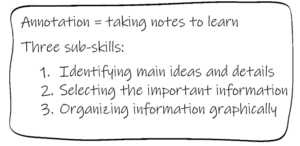Lesson of the Week
Welcome to the first week of Module IV! This week’s lesson is an overview of the content we want you to learn. This lesson is going to introduce the skill of annotation, an important study skill that requires advanced reading and note-taking strategies. Knowing how to annotate will help you learn better. Study the material below before the week starts.
Annotation
In the previous reading lessons, you learned extensively to identify the main ideas and details. You also studied different text patterns and practiced recognizing them by looking at signal words. All these skills are necessary if you want to master the skill of annotation. Annotation means taking notes of the texts with the purpose of learning from them.
Annotation is the most advanced reading skill you will learn in this course because it combines many other sub-skills. First, you need to understand the text’s main and supporting ideas and its organization. You also need to be able to select the information that is important to learn. Finally, you need to be able to organize this information graphically. When you annotate, you analyze the text, and it helps you learn better.
If you wanted to annotate the text above, you would need to ask yourself: What does the author of this text want me to learn? Since this text is dedicated to annotation, the most likely focus would be the definition and the main components:

After analyzing the text, the student would take notes of this text:

Most of the time, the main ideas are important. So, we can go ahead and highlight the topic sentence or the thesis statement. But what about other ideas? Not all supporting details are important. Some might be meaningful to the author but not necessarily have any value to us. This concerns names and dates. In a comparison paragraph, the year 1987 might not have the same importance as in a chronological paragraph. To annotate effectively, follow the tips below:
- Start with highlighting or otherwise marking main ideas. Avoid underlining only one word or an incomplete phrase. Your highlights should make sense when read.
- Always identify the pattern of the paragraph. For example, if it is a listing paragraph, the list of points must be the most critical information in this paragraph.
- Organize the highlighted information in the form of notes. Your notes have to be short points written in your own words. Avoid copying the text from the book. Paraphrase some parts to make them easier to understand.
- Use symbols wherever necessary to save time. For example, instead of the word and, you might choose to use the symbol “&”.
- Choose a graphic organizer to present your notes. For a process or a sequence of events, use a timeline. For a comparison – separate the page into two parts and write notes simultaneously.
In-Class Materials
This section contains materials that you will need for your in-class practice. If there is a video or reading you are required to watch in class, chances are it’s here!
